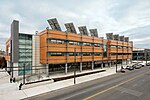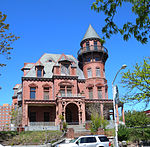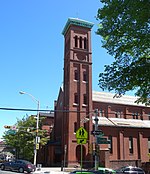Prince Street Synagogue
Ashkenazi Jewish culture in New JerseyBuildings and structures in Newark, New JerseyCulture of Newark, New JerseyCzech-Jewish culture in the United StatesJews and Judaism in Newark, New Jersey ... and 8 more
Moorish Revival architecture in New JerseyMoorish Revival synagoguesNew Jersey Register of Historic PlacesNew Jersey religious building and structure stubsReligious buildings and structures in Essex County, New JerseySynagogues completed in 1884Synagogues in New JerseyUnited States synagogue stubs
Prince Street Synagogue (Oheb Shalom), in the Springfield/Belmont neighborhood, is the oldest synagogue building still standing in Newark, Essex County, New Jersey, United States.Documentation records note Prince Street in Newark, New Jersey as a being one of the earliest, relatively clandestine places of Jewish settlement and worship (primarily Sephardic Jews of Spanish, Portuguese, or Italian descent) in the colonial and early American eras. The later arriving Ashkenazi Jews of Newark, New Jersey accommodated to the areas in and around Prince Street, named for one of the original anglicized Sephardic family names.
Excerpt from the Wikipedia article Prince Street Synagogue (License: CC BY-SA 3.0, Authors).Prince Street Synagogue
Prince Street, Newark
Geographical coordinates (GPS) Address Nearby Places Show on map
Geographical coordinates (GPS)
| Latitude | Longitude |
|---|---|
| N 40.73612 ° | E -74.185393 ° |
Address
Prince Street 4
07103 Newark
New Jersey, United States
Open on Google Maps






